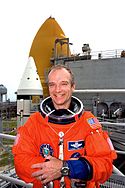Charles Joseph Precourt
| Charles Joseph Precourt | |
|---|---|
 Charles Joseph Precourt | |
| Astronaut NASA | |
| Státní příslušnost | |
| Datum narození | 29. června 1955 (68 let) |
| Místo narození | Waltham, Massachusetts |
| Předchozí zaměstnání | testovací pilot |
| Hodnost | plukovník USAF |
| Čas ve vesmíru | 38 dní, 20 hodiny a 16 minut |
| Kosmonaut od | 1990 |
| Mise | STS-55, STS-71, STS-84, STS-91 |
| Znaky misí | |
| Některá data mohou pocházet z datové položky. | |
Charles Joseph Precourt (* 29. června 1955 v Walthamu, stát Massachusetts, USA) je letec, důstojník a americký kosmonaut. Ve vesmíru byl čtyřikrát.
Život
Studium a zaměstnání
Absolvoval střední školu Hudson High School (1973) a pak pokračoval ve studiu na vojenské letecké akademii USAF Academy. Zde dostudoval v roce 1988. U letectva zůstal.
V letech 1990 až 1991 v Houstonu absolvoval výcvik budoucích kosmonautů a od roku 1991 se stal členem tamní skupiny astronautů při NASA.
Oženil se s Lynne Denisou, rozenou Mungleovou.
Lety do vesmíru
Na oběžnou dráhu se v raketoplánech dostal čtyřikrát a strávil ve vesmíru 38 dní, 20 hodin a 16 minut. Pracoval i na orbitální stanici MIR. Byl 289 člověkem ve vesmíru.
- STS-55 Columbia (26. duben 1993 – 6. květen 1993), letový specialista
- STS-71 Atlantis (27. června 1995 – 7. července 1995), pilot
- STS-84 Atlantis (15. května 1997 – 24. května 1997), velitel
- STS-91 Discovery (2. června 1998 – 12. června 1998), velitel
Odkazy
Externí odkazy
 Obrázky, zvuky či videa k tématu Charles Joseph Precourt na Wikimedia Commons
Obrázky, zvuky či videa k tématu Charles Joseph Precourt na Wikimedia Commons - Na webu Space
- Na webu MEK-Kosmo
Média použitá na této stránce
STS-55 Mission Insignia
STS-91 CREW INSIGNIA (March 1998) --- This is the crew patch for the STS-91 mission -- the ninth flight of the Shuttle-Mir Phase One docking missions. The crew will bring back Andrew S. W. Thomas, the last long-duration American crew member flown on the Russian Space Station Mir. This mission marks the end of the Shuttle-Mir Phase One Program and will open the way for Phase Two: construction of the International Space Station (ISS). The crew patch depicts the rendezvous of the Space Shuttle Discovery with the Space Station Mir. The flags of the United States and Russia are displayed at the top of the patch and both countries are visible on the Earth behind the two spacecraft. The names of the American crew members surround the insignia on the outer areas, with the name of cosmonaut Valery Ryumin in Cyrillic at the lower right. The Alpha Magnetic Spectrometer (AMS) is an international payload planned to fly in the payload bay of Discovery. Two thin golden streams flowing into the AMS represent charged elementary particles. The detection of antimatter in space will help scientists better understand the physics and origins of the universe.
STS-71 Mission Insignia
The STS-71 crew patch design depicts the orbiter Atlantis in the process of the first international docking mission of the Space Shuttle Atlantis with the Russian Space Station Mir. The names of the 10 astronauts and cosmonauts who flew aboard the orbiter are shown along the outer border of the patch. The rising sun symbolizes the dawn of a new era of cooperation between the two countries. The vehicles Atlantis and Mir are shown in separate circles converging at the center of the emblem symbolizing the merger of the space programs of the two space faring nations. The flags of the United States and Russia emphasize the equal partnership of the mission. The joint program symbol at the lower center of the patch acknowledges the extensive contributions made by the Mission Control Centers (MCC) of both countries. The crew insignia was designed by aviation and space artist, Bob McCall, who also designed the crew patch for the Apollo Soyuz Test Project (ASTP) in 1975, the first international space docking mission.
The STS-84 emblem depicts the Space Shuttle Atlantis launching into Earth orbit to join the Russian Space Station Mir as part of Phase One (Shuttle-Mir) of the International Space Station program. The names of the eight astronauts who flew onboard Atlantis, including the two who changed their positions onboard Mir for a long duration flight, are shown along the border of the patch. The STS-84/Mir-23 team will transfer 7,000 pounds of experiments, Station hardware, food and clothing to and from Mir during the five-day period of docking. The Phase One program is represented by the rising Sun and by the Greek letter Phi followed by one star. This sixth Shuttle-Mir docking mission is symbolized by the six stars surrounding the word Mir in Cyrillic characters. Combined, the seven stars symbolize the current configuration of Mir, composed of six modules launched by the Russians and one module brought up by Atlantis on a previous docking flight.
STS-91 Mission Commander Charles Precourt pauses on the 217-foot level of Launch Complex 39A after the completion of Terminal Countdown Demonstration Test (TCDT) activities. Behind him, the Space Shuttle Discovery is being prepared for flight.





